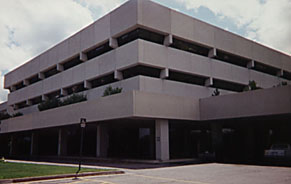The Dow Corning Corporation
Case A
Go back to Part 2
dccpart3.rtf Part 3: THE DOW CORNING CORPORATION
[13]
 Founded in 1943, the Dow Corning Corporation is a jointly owned
business in commercial silicone technology by The Dow Chemical Company and
Corning, Incorporated. Corning Glassworks had researched the commercial
potential of silicone in the 1930's and early 1940's. What Corning needed,
however, was an experienced chemical company to assist them in manufacturing
this new ingredient, a company like the chemical industry giant, The Dow
Chemical Company.
Founded in 1943, the Dow Corning Corporation is a jointly owned
business in commercial silicone technology by The Dow Chemical Company and
Corning, Incorporated. Corning Glassworks had researched the commercial
potential of silicone in the 1930's and early 1940's. What Corning needed,
however, was an experienced chemical company to assist them in manufacturing
this new ingredient, a company like the chemical industry giant, The Dow
Chemical Company.
With Dow Chemical's experience and Corning's ideas, silicone would grow to be
indispensable, finding applications in the aerospace, electronic, medical
products, and construction industries, among others. Dow Corning's first
triumph was a sealant used to protect Allied fighter planes' ignitions from
failure at high altitudes during the Second World War. When the war was over,
Dow Corning explored non-defense applications of silicone, eventually creating
more than 5,000 silicone products. Dow Corning continued to emphasize research
and expansion throughout the 1950's and 1960's. During this time, the company
ordered a substantial amount of testing on silicones' effects, both on
organisms and the environment, though not required to do so by any Food &
Drug Administration (FDA) regulations. Typically, silicone was found to be
chemically inert, failing to cause harmful reactions in rats, monkeys, or even
human embryonic cells. With such a characteristic, silicone seemed the perfect
candidate for use in medical applications, for instance, in synthetic coverings
for burn patients, in a coating on needles to ease insertion, and even in
implantable devices like the heart pacemaker.
To further encourage research in this area, Dow Corning opened the Center for
Aid to Medical Research (CAMR) as a source of silicone for in-house and
independent medical researchers. Thus, in the early 1960,'s Dow Corning
supplied Texas plastic surgeons Frank Gerow and Thomas Cronin with silicone for
their medical implant device research. Gerow and Cronin, using Dow Corning
silicone, invented the first silicone breast implant as a device to aid women
who had undergone mastectomies or had congenital breast deformities. Although
the FDA had no regulations governing implantable devices, the surgeons
conducted two years of clinical trials on the implant prior to Dow Corning's
product introduction in 1964. In the next several years, the implant grew
popular for cosmetic surgery as well as reconstructive, and Dow Corning
cornered both markets.
Not just an innovator in silicone technology, Dow Corning proved itself a
leader in organizational management. In 1967, it adopted a matrix management
structure, eventually called Dow Corning's "multidimensional management
structure."[14] Instead
of the traditional
divisions only along product lines, they organized themselves into a
two-dimensional matrix with profit centers (i.e. business types) as the row
headings and cost centers (departments) as the column headings. The resulting
rows formed business boards according to product category, such as electronics,
with one business manager and a representative from Marketing, Research,
Manufacturing, Technical Service & Development, and Finance. (The
multitude of countries across which this matrix was implemented was the third
dimension, and time was the fourth. Hence it's classification as
multi-dimensional.)

(Click here to see full-sized matrix.)
These business boards allowed for improved communication
among different departments and decision making at lower levels. Within this
structure, Dow Corning formed Product Management Groups, PMG's, similar in
form to the business boards, except that PMG's focused on planning for a
certain product and consisted of representatives from the lower rungs of
department ladders. Even more focused were the ad/hoc task forces occasionally
developed to speed a particular product to market.
Go on to Part 4
 Founded in 1943, the Dow Corning Corporation is a jointly owned
business in commercial silicone technology by The Dow Chemical Company and
Corning, Incorporated. Corning Glassworks had researched the commercial
potential of silicone in the 1930's and early 1940's. What Corning needed,
however, was an experienced chemical company to assist them in manufacturing
this new ingredient, a company like the chemical industry giant, The Dow
Chemical Company.
Founded in 1943, the Dow Corning Corporation is a jointly owned
business in commercial silicone technology by The Dow Chemical Company and
Corning, Incorporated. Corning Glassworks had researched the commercial
potential of silicone in the 1930's and early 1940's. What Corning needed,
however, was an experienced chemical company to assist them in manufacturing
this new ingredient, a company like the chemical industry giant, The Dow
Chemical Company.